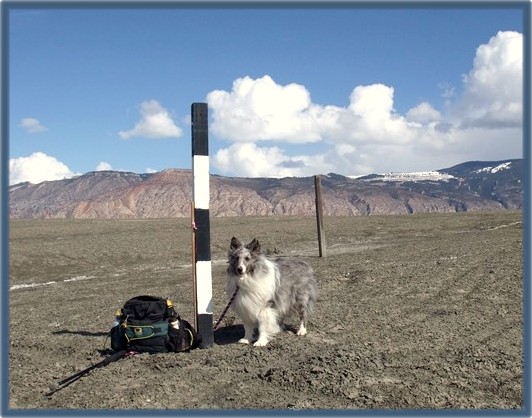

Heart Mountain Shelties Heart Mountain Shelties Home
The Shetland Sheepdog breed originated from 19th century
native dogs inhabiting the Shetlands Islands. Narrow, these exhibit miles of
rocky coastlines and cliffs. Comprising the northernmost reaches of Scotland,
the rugged landscape endures frequent North Atlantic storms. Hardy, smaller
versions of various animals such as the Shetland pony and diminutive cattle were
perpetuated to endure the comparatively harsher climate and terrain compared to
the mainland. Farms were challenged by the rapid erosion of the typically
thin Shetland soils (Mills 1999). Livestock typically were allowed to forage
freely, while the few cultivated crops were protected in walled gardens on the
tiny “toons” (derived from the Norwegian word “tun” for farm) or unfenced.
However, the nimble island animals were noted for jumping over the stone walls
to graze on the crops.
By the mid 19’th century, the Shetland islanders began breeding agile, small
dogs which they called “Toonies” to keep the ponies and sheep out of their crops
as well as to work to work sheep. In addition to fishing, one of the main
occupations was raising Shetland sheep whose long soft wool was in worldwide
demand (McKinney and Rieseberg 1976). During the summer, herds were often
transported via ferry to the smaller outlying islands. The sheep were left with
the dog placed in charge while the crofter made occasional checks. The stock
were rounded up in the fall by the dogs then brought back to the main island.

The actual mix of dogs that developed the breed remains a mystery. While
the collie was obviously involved, other breeds such as Northern Spitz,
Pomeranian, Icelandic Yakkie, etc. may have contributed genes. The origin
of the merle gene is more mysterious. Dating to about 1840, an engraving in
Lerwick (main port of Shetland Islands, Scotland) depicts a Sheltie or very
similar looking dog in the background (Scottish Shetland Sheepdog Association
n.d.)
By around 1890, the Toonies numbers began diminishing which alarmed British dog
fanciers (Mills 1999). Sailors from whaling vessels reportedly had taken many of
the dogs away to function as ship dogs or gifts to loved ones at home.
Furthermore, economical changes were placing importance on other types of
herding dogs. The Scottish and English breeders set about preserving and
defining the breed. Standard collies were often bred in to achieve uniformity in
size, coat, and other attributes. In 1908, the Shetland Collie Club was founded
in Lerwick to perpetuate the breed while the Scottish Shetland Sheepdog Club was
established in 1909. The Kennel Club (United Kingdom Kennel Club or UKC)
recognized the breed in 1914 with the official breed name of Shetland Sheepdog.
The Shetland Collie term was dropped due to the objections of collie fanciers.
The first Shelties arrived in the United States in 1908, but the breed wasn’t
AKC (American Kennel Club) recognized until 1911. Because of past collie crosses
listed in their pedigrees, many of the imported dogs were considered not
eligible for AKC registration. Sadly at one time, there were only two male
Shelties in the United States considered eligible for breeding (American
Shetland Sheepdog Association n.d.). This was largely due to a difference in
“acceptable degrees” of breed purity between the AKC and UKC. During that time,
the UKC accepted dogs with collie crosses in their pedigrees provided that the
offspring were bred back for at least three generations to Shetland Sheepdogs.
After the mandatory passage of the required three generations, the offspring
were deemed purebred and satisfactory for registration. Sadly at one time, there
were only two male Shelties in the United States considered eligible for
breeding.
An early importer of the breed, Catherine Coleman Moore
made the lengthy voyage to England to approach the English Kennel Club in an
attempt to have the collie pedigree notations removed. The trip proved
successful and subsequent imports were accepted by the AKC. Ms. Moore (Sheltieland
Kennels) later became a founding member of the American Shetland Sheepdog
Association and the first to record a Sheltie litter with the AKC. She was
assisted by Ms. Clara Bowing (Larkbeare Kennels), a wealthy patron of the breed
and future secretary of the English Shetland Sheepdog Club.
References Cited:
American Shetland Sheepdog Association
n.d. Web site at http://www.assa.org/SheltieHistory.html.
McKinney, Betty Jo and Barbara Hagen Rieseberg
1976 Sheltie Talk. Alpine Publications, Loveland, Colorado.
Miller, Beverly
1999 Shetland Sheepdogs. Web site at http://www.k9web.com/dog- faqs/breeds/shelties.html.
Scottish Shetland Sheepdog Club
n.d. Web site at http://www.scottish-sheltie.org.uk/index.htm